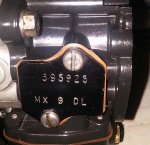Strangeleak
Seaman
- Joined
- Jan 20, 2017
- Messages
- 55
Hi Everyone,
I have Engine Model VJ120TLEIE with #4 cylinder not firing and an occasional-frequent cough/sneeze at idle that eventually stalls the engine. I've confirmed compression, and the presence of fuel, and spark up to the spark plug(could be fouled). I have ordered new plugs to try soon though.
I was hoping to get some information from someone with the same engine as me. In regard to the two orifices on the front opening of the carburetors for idle and intermediate jetting. On my engine, the "upper" idle orifice has 22 etched into it and the "lower" intermediate orifice has 24 etched into it.
Can anyone with a properly running 120 confirm that this is correct for this engine? Or if larger/smaller jetting is necessary for an older engine.
I have tried searching the web for the correct sizes but have only found numbers for the 140hp model engine of that year for the idle orifice and the intermediate orifice is supposed to be a #27(mines #24) according to another website. But I don't know if that is correct.
Also, what is the standard running position of the primer solenoid valve? Mine can rotate between 12 and 6 o'clock positions.
Thanks,
Nate
I have Engine Model VJ120TLEIE with #4 cylinder not firing and an occasional-frequent cough/sneeze at idle that eventually stalls the engine. I've confirmed compression, and the presence of fuel, and spark up to the spark plug(could be fouled). I have ordered new plugs to try soon though.
I was hoping to get some information from someone with the same engine as me. In regard to the two orifices on the front opening of the carburetors for idle and intermediate jetting. On my engine, the "upper" idle orifice has 22 etched into it and the "lower" intermediate orifice has 24 etched into it.
Can anyone with a properly running 120 confirm that this is correct for this engine? Or if larger/smaller jetting is necessary for an older engine.
I have tried searching the web for the correct sizes but have only found numbers for the 140hp model engine of that year for the idle orifice and the intermediate orifice is supposed to be a #27(mines #24) according to another website. But I don't know if that is correct.
Also, what is the standard running position of the primer solenoid valve? Mine can rotate between 12 and 6 o'clock positions.
Thanks,
Nate





















